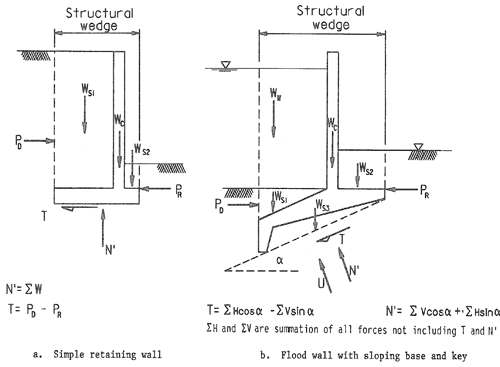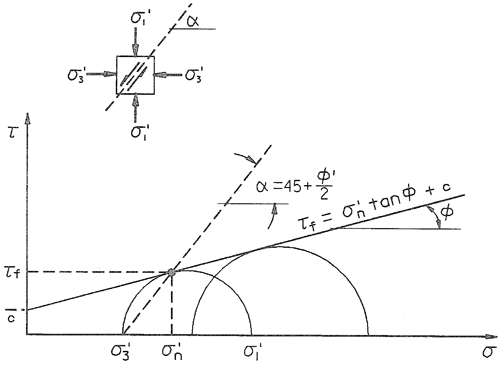| 1. |
A retaining wall is: |
|
|
Any wall that retains material to maintain a change in elevation whereas the principal function of a floodwall is to prevent flooding (inundation) of adjacent land. |
|
|
Any wall that stops the outside intrusions |
| 2. |
The most common types of retaining walls are:
I. Gravity concrete walls.
II. Cantilever T-type reinforced concrete walls.
III. Cantilever and anchored sheet pile walls.
|
|
|
I & II |
|
|
III |
|
|
I, II & III |
| 3. |
The effective earth pressure on the base is assumed to vary linearly and N’ is applied at the centroid of the pressure diagram. When the resultant falls within the middle one-third of the base, the effective base pressures q’ are calculated by the following equation: (Refer Chapter 3 Pg. 3-9)

Where
N’ = effective normal force on base of structure
e = eccentricity of N’ from center of base
B =?
What does B stand for? |
|
|
Basic shear |
|
|
Width of the base of structure |
|
|
Amount of backfill material |
|
|
None of the above |
| 4. |
The purpose of the geotechnical investigation for wall design is:
a) To identify the type and distribution of foundation materials.
b) To identify sources and characteristics of backfill materials.
c) To determine material parameters for use in design analyses.
|
|
|
All of the above |
|
|
Only a & c |
| 5. |

Figure 1.1.0
What does figure 1.1.0 explain? |
|
|
Forces on a base wall |
|
|
Force polygon for wedge method on driving side |
|
|
Variables used in Coulomb equation |
|
|
None of the above |
| 6. |
The basic requirements for the stability of a retaining or floodwall for all loading conditions are as follows:
a) The wall should be safe against sliding at its base, through any soil layer or rock seam below the base.
b) The wall should be safe against overturning at its base, and, in the case of gravity walls, at any horizontal plane within the wall.
c) The wall should be safe against bearing failure and excessive differential settlement in the foundation.
|
|
|
All of the above |
|
|
b & c |
| 7. |
When the impervious top stratum is thin or non-existent, |
|
|
A trench drain may be used to control under seepage in the vicinity of the floodwall toe. |
|
|
A floodwall should be constructed upstream |
| 8. |
Sewer pipes with open joints, structures with basements, and excavations close to the wall: |
|
|
May create a hazard to the safety of a floodwall. |
|
|
May flood the floodwall |
| 9. |

Figure 1.2.0
Figure 1.2.0 represents Mohr-Coulomb failure criterion |
|
|
True |
|
|
False |
| 10. |
The effective earth pressure may be assumed to have a triangular distribution when all of the following conditions hold:
- The wall will not move or it will rotate about the base.
- The water table is at or below the base of the wall or at or above the top of the wall (submerged soil).
- Water conditions are hydrostatic (no seepage).
- There is only one soil material.
- There is no cohesion (c = 0).
- The backfill surface is plane (it may be inclined).
|
|
|
All of the above |
|
|
Only 1, 3 and 4 |
| 11. |
Horizontal Earth Pressure (P’hz) is given by:
(Refer chapter 3. Pg.3-39)

K = K o on the driving side. K for the resisting side could vary between Kp (passive pressure Coefficient) and Ko (active pressure coefficient) or could be taken as zero
Y ‘ = the effective unit weight (total, saturated or moist unit weight if above the water table, buoyant or submerged unit weight if below the water table)
Z =?
What does Z mean in the above formula?
|
|
|
Vertical distance measured down from the backfill surface |
|
|
Shear stress |
|
|
Active pressure |
|
|
None of the above |
| 12. |
Flood wall instrumentation should be considered so that performance can be monitored, particularly during periods of |
|
|
High water. |
|
|
Full moon |
| 13. |
A strip of material, cast into each of two adjacent concrete monoliths and spanning the space between them, for the purpose of preventing the flow of water through the space is called:. |
|
|
a water stop |
|
|
a water gauge |
| 14. |
The most obvious and straightforward method for reducing anticipated horizontal movement or increasing sliding stability is the addition of landside cover or fill to the wall. |
|
|
True |
|
|
False |
| 15. |
Factors that favor the concrete gravity retaining walls are shallow depth of overburden, a competent foundation, and an adequate source of fine and coarse aggregate for the required volume of concrete. |
|
|
True |
|
|
False |
| 16. |
A concrete compressive strength of: |
|
|
1500 psi will meet the requirements for a gravity retaining type wall. |
|
|
25000 psi will meet the requirements for a gravity retaining type wall. |
| 17. |
The cantilever reinforced concrete wall is a special type of gravity wall in which part of the stabilizing weight is supplied by the weight of the backfill resting on the base slab. |
|
|
True |
|
|
False |
| 18. |
A force acting to move the wall, caused by earth and water beyond the end of the heel is called: |
|
|
The driving force |
|
|
The destablizing force |
| 19. |
Pressure condition that develops when a wall is moved toward backfill, causing horizontal stresses to increase and shear stresses to reverse direction is called: |
|
|
Active earth pressure |
|
|
Negative hydrostatic force |
| 20. |
Drained soil tests are the tests: |
|
|
in which the confining and shear stresses are applied so slowly that pore water pressure does not build up. |
|
|
That the soil is drained so that its physical strength and characteristic can be measured. |
|